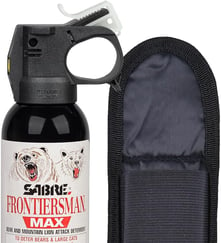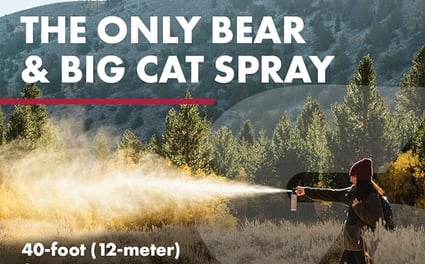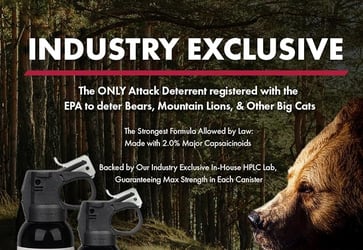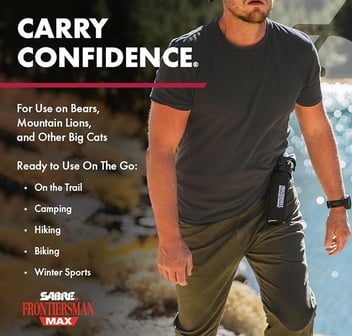How Bear Spray Works: A Quick Guide
SURVIVALFRONT PAGE
2/26/20247 min read
The Chemical Science Behind Bear Spray
Bear spray utilizes the active ingredient capsaicin, a compound derived from chili peppers, which is responsible for the spicy heat sensation. When concentrated, capsaicinoids—the family of compounds to which capsaicin belongs—act as a potent irritant, affecting the eyes, skin, and respiratory system of bears, causing temporary discomfort and incapacitation. This mechanism is crucial for providing individuals with a non-lethal means to protect themselves during unexpected bear encounters. The effectiveness of bear spray hinges on its ability to create an immediate sensory overload in bears, triggering an instinctual desire to flee from the source of irritation, thereby reducing the likelihood of a human-bear conflict.
The concentration of capsaicinoids in bear spray is regulated and typically ranges between 1% to 2%, a level found to be most effective in deterring bears without causing permanent harm. Research into the exact physiological effects on bears has shown that the spray causes an intense burning sensation, leading to temporary blindness and severe respiratory distress. This reaction is fast-acting, giving humans a critical window to retreat to safety. The formulation of bear spray also includes a propellant that allows it to be ejected as a cloud, creating a barrier between the user and the bear, which is essential for its role as a deterrent in close-range encounters.
Comparative Effectiveness of Bear Spray
The debate on the most effective bear deterrent has prompted extensive scientific research, comparing bear spray to other methods, such as firearms. Studies have consistently shown that bear spray is highly effective, with success rates exceeding 90% in deterring aggressive bear behaviors. This effectiveness is attributed to the spray’s ability to function as a non-lethal, immediate deterrent, unlike firearms, which require precision under pressure and carry the risk of wounding the animal without stopping an attack. Furthermore, the use of bear spray does not depend on the user's aim to the same extent as firearms, making it more reliable in high-stress situations. The analysis of bear spray incidents versus those involving firearms highlights the importance of choosing a deterrent method that is both humane and highly effective in protecting human life while preserving bear populations.
Deployment Techniques for Bear Spray
Understanding the correct deployment techniques for bear spray is crucial for ensuring its effectiveness in a real-world encounter. This section covers the essential steps and considerations to maximize your safety and the deterrent's efficacy during a bear encounter.
Assess the Situation: Before deploying bear spray, quickly assess the bear's behavior and distance. If the bear has not noticed you, slowly back away without drawing attention.
Remove Safety: Bear spray canisters come with a safety mechanism to prevent accidental discharge. In anticipation of use, calmly remove the safety with deliberate action.
Firm Grip and Stance: Hold the canister with both hands if possible, and plant your feet firmly on the ground. Stability is key to accurate deployment.
Aim Slightly Downward: Aim the nozzle slightly downward, as bear spray is released as a cloud that rises and expands. This ensures the spray intercepts the bear's path.
Spray in Short Bursts: Use short, controlled bursts to conserve the bear spray. This technique allows for adjustments based on the bear's movements and distance.
Create a Barrier: Aim to create a cloud barrier between you and the approaching bear. The spray should be deployed before the bear is within 25 feet to allow the cloud to expand.
Retreat Slowly: After deployment, retreat slowly without turning your back to the bear. Do not run, as this can trigger a chase response.
Best Practices for Bear Spray Readiness
Ensuring your bear spray is readily accessible and you are prepared to use it effectively are key elements in bear encounter safety.
Accessibility: Always carry bear spray in a holster on your belt or the front of your backpack. Time is of the essence, and the spray should be within arm's reach at all times.
Regular Checks: Regularly check the expiration date and condition of your bear spray. A canister that is past its expiration date may not perform effectively.
Practice Drills: Familiarize yourself with the feel and operation of the bear spray canister. Practice removing the safety and aiming motions in a safe, controlled environment to reduce panic in an actual encounter.
Conversely, using a gun requires precision under pressure and can result in lethal consequences for the animal. The risk of ineffective shot placement increases under stress, potentially aggravating the situation rather than defusing it. Additionally, gunfire can attract further attention, not to mention the ethical and legal implications of killing wildlife, especially in protected areas. Given these considerations, bear spray is recommended by wildlife experts and authorities as the safer and more humane option for both humans and bears in confrontational scenarios. This preference aligns with a broader commitment to conservation and non-lethal wildlife management practices.
Bear Spray Expiration
One thing to always keep in mind is that unlike ammo, the shelf life of bear spray is much shorter. Make sure you do the following to ensure that you're not accidentally holding onto something expired.
Shelf Life: Most bear spray manufacturers indicate a shelf life of 3 to 4 years. However, the effectiveness of the spray can diminish over time, so it's crucial to check the expiration date before heading out.
Chemical Degradation: The active ingredients in bear spray, such as capsaicin and related capsaicinoids, can degrade over time, reducing the spray's potency and range.
Pressure Loss: Aerosol canisters may lose pressure over time, even if the seal remains intact. A loss of pressure can affect the spray's range and density, making it less effective in deterring an aggressive animal.
Storage Conditions: Extreme temperatures and improper storage can accelerate the degradation of bear spray. It's recommended to store bear spray in cool, dry conditions away from direct sunlight.
Regular Checks: Regularly inspect the canister for any signs of damage or leakage, and test the spray mechanism to ensure it's working correctly (without discharging it, if possible).
Replacement: Always replace expired or compromised bear spray canisters, even if they appear to be full. It's a small investment for safety in bear country.
Disposal: Expired or unused bear spray should be disposed of according to local regulations, often requiring it to be treated as hazardous waste.
"Only Bear & Big Cat Spray"
Bear Spray Effectiveness Against Mountain Lions
Bear spray, traditionally seen as a deterrent for bear encounters in the wilderness, has garnered attention for its potential effectiveness against other wildlife threats, notably mountain lions. While the primary design of bear spray is to ward off bears with its potent capsaicin content, the chemical's intense irritant effects are not species-specific. This broad-spectrum use suggests that bear spray can also be a critical tool in enhancing safety during rare but potentially dangerous encounters with mountain lions.
Encounters with mountain lions, also known as cougars, are significantly less common than those with bears, and attacks on humans are even rarer. Despite these low statistics, wildlife experts advocate for the precautionary carrying of bear spray in areas known for mountain lion activity. The rationale is straightforward: in the unlikely event of an aggressive encounter, having bear spray provides a non-lethal means to defend oneself and deter the animal.
Bear Spray Storage Guidelines
Proper storage of bear spray is paramount to ensuring its efficacy and longevity. Bear spray contains capsaicinoids, which are susceptible to degradation if exposed to extreme temperatures or direct sunlight. To maximize its shelf life, bear spray should be stored in a cool, dry place, away from direct heat sources or freezing conditions. Temperature fluctuations can compromise the canister's integrity and the potency of the spray, rendering it less effective or even unusable.
Bear Spray vs. Gun in Wildlife Encounters
The debate between using bear spray versus a gun in wildlife encounters hinges on effectiveness, safety, and ecological impact. Bear spray, a non-lethal deterrent, is designed to stop an aggressive bear without causing permanent harm. Its efficacy lies in creating a cloud of capsaicinoids that irritates the bear's eyes, nose, and lungs, providing the user time to escape. Studies have shown that bear spray is highly effective in deterring bear attacks, with success rates exceeding 90% in various incidents.
We recommend Frontiersman Bear Spray.
"Ensure whatever Bear Spray system you get is durable."
As an Amazon Affiliate items and images are linked on this page and may earn our team commission. We pick the products - no catch.
OUR PICK: Frontiersman MAX Bear & Mountain Lion Spray
Frontiersman MAX: Ultimate Predator Defense
Extended Reach for Enhanced Safety: Frontiersman MAX has an impressive 40-foot (12-meter) range, outdistancing competitors by up to 20 feet.
Unrivaled Stopping Power for Peace of Mind: The sole bear spray recognized by the EPA for use against mountain lions and other large predators. Featuring a potent 2.0% Major Capsaicinoids concentration, the most powerful formula permitted by law.
onewordsurvive.com
Contact | Questions | Ideas
survive@onewordsurvive.com
Cookie Notice: Our website uses cookies to enhance your browsing experience. By continuing to use our site, you agree to our use of cookies. If you wish to manage your cookie preferences, you may do so in your browser settings.
As an Amazon Affiliate, our team may earn money from qualifying purchases. This page may contain affiliate links, which means if you click through and make a purchase, we may receive a commission at no additional cost to you. This helps support our research and editorial team, and please know we only recommend high-quality products.














